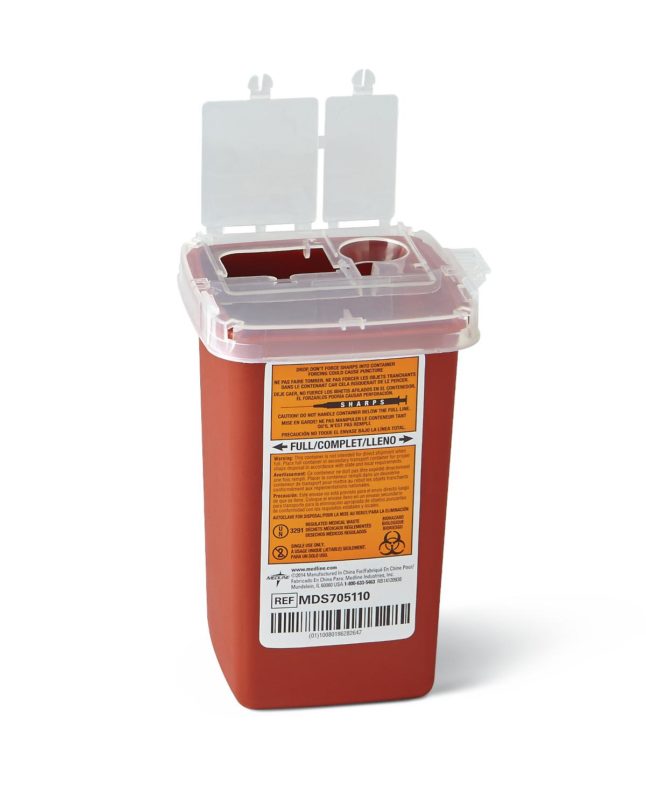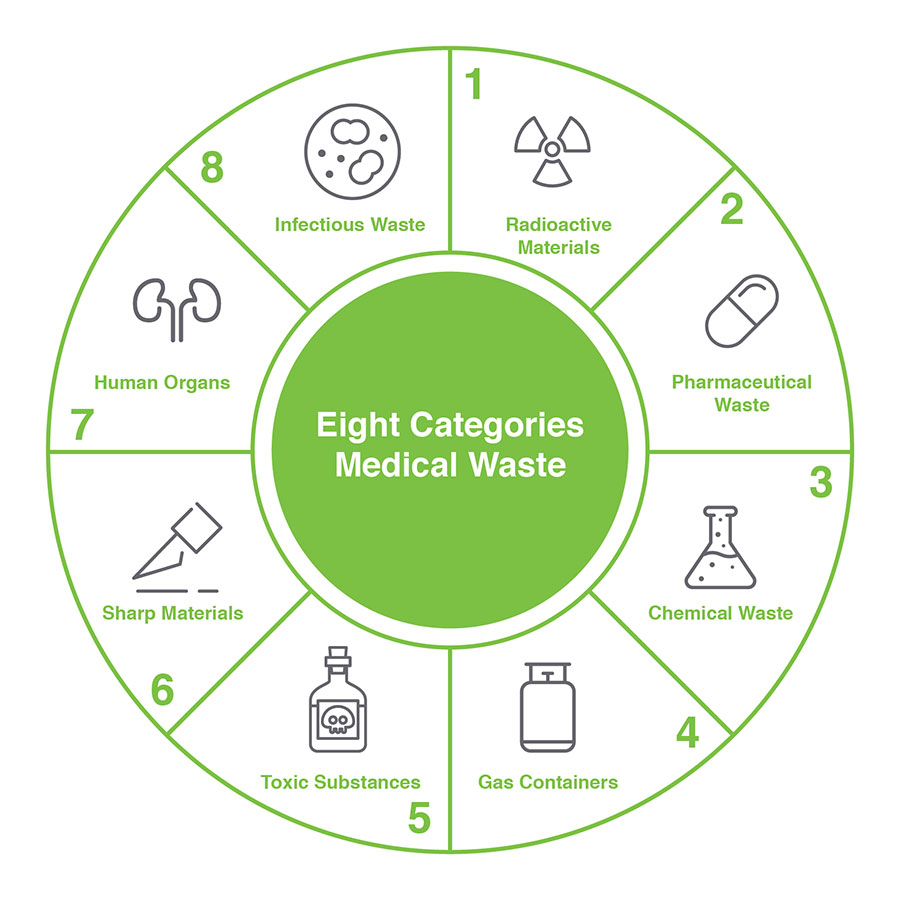Minimize Prices and Make The Most Of Safety: Effective Medical Waste Disposal Strategies
Effective medical garbage disposal approaches are critical for medical care centers to reduce expenses and make the most of safety. With the expanding problem for ecological sustainability and the enhancing number of laws bordering waste administration, it is vital for healthcare companies to embrace certified and efficient techniques. By carrying out appropriate partition and classification, efficient product packaging and labeling, risk-free transport and handling, efficient treatment and disposal approaches, and compliance with governing guidelines, healthcare centers can guarantee the secure and accountable management of medical waste. In this discussion, we will discover each of these methods thoroughly, supplying insights and functional tips for health care professionals to enhance their waste disposal processes.

Proper Segregation and Categorization
Appropriate segregation and classification are critical parts of effective medical waste disposal techniques, ensuring the safety of healthcare workers, the public, and the environment - medical waste removal service. medical waste disposal services with WasteX. By separating different sorts of medical waste at the point of generation, healthcare facilities can lessen the danger of cross-contamination and potential damage to ecosystems and people
One of the key variables in appropriate segregation is the recognition and classification of clinical waste. This includes classifying waste into various groups, such as infectious, harmful, radioactive, or pharmaceutical waste. Each group requires details handling, storage, and disposal approaches to avoid any kind of unfavorable results on human health and wellness and the setting.
Additionally, correct segregation likewise includes using color-coded labels and containers to plainly recognize and distinguish the numerous sorts of clinical waste. This aids healthcare employees and waste monitoring personnel to quickly identify and deal with the waste properly. Red containers might be utilized for transmittable waste, while yellow containers may be designated for dangerous waste.
In enhancement to partition, proper categorization likewise entails the proper packaging and containment of medical waste. This makes sure that waste is firmly stored and moved without posturing any kind of risks to individuals or the environment. Utilizing watertight and puncture-resistant containers, along with correctly sealing and identifying them, assists to avoid any kind of accidental exposure or release of hazardous substances.
Efficient Packaging and Labeling
Efficient packaging and labeling play a crucial role in guaranteeing the effective and safe disposal of medical waste. Correct product packaging is important to prevent leak, damage, or splilling during transportation and handling. It helps to decrease the threat of contamination and shields health care workers, waste management personnel, and the setting from possible dangers.
Medical waste needs to be packaged in leak-proof and tough containers that are resistant to puncture and damage. These containers should be correctly sealed to stop any kind of leakage. Additionally, the product packaging must be able to withstand the problems of transportation, including temperature level variations and misuse.
Classifying is similarly important as it gives important information about the materials of the waste and any type of potential dangers related to it. The tags ought to consist of the name of the health care center, the sort of waste, and any special delivery instructions. Standardized and clear labeling makes sure that waste management employees can easily determine and handle the waste properly.
Efficient packaging and labeling additionally aid in the appropriate segregation and categorization of clinical waste. Clear labeling enables simple recognition of different waste streams, such as transmittable waste, sharps, or pharmaceutical waste. This helps in enhancing the disposal procedure and guaranteeing that the waste is dealt with or disposed of according to governing guidelines.
Safe Transportation and Handling
Making sure the safe transportation and handling of clinical waste is of utmost relevance in order to prevent any type of possible health and environmental dangers. Clinical medical waste disposal services with WasteX waste, such as sharps, infected materials, and pharmaceutical waste, should be appropriately packaged and taken care of to minimize the risk of exposure to dangerous materials and pathogens.
Carrying clinical waste needs conformity with rigorous laws and guidelines set by environmental agencies and local authorities. These policies aim to safeguard the health and wellness of employees entailed in waste monitoring and protect against the launch of unsafe products right into the setting.
To make certain secure transport, clinical waste must be positioned in puncture-resistant and leak-proof containers that are appropriately sealed and labeled. These containers should be secured in a manner that protects against spills or damage throughout transportation (medical waste removal near me). In addition, it is vital to utilize specific cars equipped with appropriate safety and security attributes to deliver medical waste. These cars should have ample air flow and be developed to prevent leak or contamination.
Dealing with clinical waste additionally requires appropriate training and adherence to safety and security protocols. Personnel associated with the handling of clinical waste need to wear proper individual safety tools (PPE) such as gloves, dress, and masks to reduce the danger of direct exposure. They must additionally adhere to strict hygiene practices to avoid the spread of infections and make sure the risk-free disposal of waste.
Efficient Therapy and Disposal Approaches
Applying ideal therapy and disposal approaches is crucial in managing medical waste effectively and minimizing potential health and environmental click this site risks. Clinical waste, that includes sharps, transmittable products, chemicals, and drugs, can present considerable threats otherwise managed and taken care of effectively. There are numerous therapy and disposal techniques available that abide by governing standards and promote safe practices.
One common method is incineration, which involves shedding the waste at high temperatures. Incineration is efficient in ruining virus and lowering the quantity of waste, yet it can launch harmful pollutants into the air otherwise effectively managed. It is vital to make use of modern-day burners furnished with discharge control technologies.
Another method is autoclaving, which makes use of vapor and pressure to sanitize the waste. Autoclaving works in killing virus and minimizing the volume of waste, but it requires mindful tracking and maintenance to ensure correct performance. The sanitized waste can then be securely thrown away in a garbage dump.
Chemical treatment is an additional choice, which involves making use of disinfectants or other chemicals to counteract microorganisms. This method is generally utilized for liquid waste, such as lab specimens. It is crucial to utilize appropriate chemicals and follow appropriate procedures to ensure reliable treatment and prevent ecological contamination.

Conformity With Regulatory Standards
Sticking to regulatory standards is essential in making sure proper compliance with clinical waste disposal methods. These standards are implemented to shield public health, stop ecological contamination, and maintain work environment safety and security. Compliance with regulative standards is critical for healthcare facilities, as non-compliance can cause fines, fines, and reputational damage.
Regulative standards lay out the proper handling, storage, transportation, and disposal of clinical waste. They give specific instructions on packaging demands, labeling, and record-keeping. These standards additionally resolve the segregation of different waste streams, such as sharps, infectious waste, and pharmaceutical waste. Healthcare facilities should make sure that their waste monitoring techniques straighten with these standards to decrease the risk of exposure to hazardous materials and prevent the spread of infections.
To preserve compliance, health care facilities should establish comprehensive waste monitoring programs that consist of personnel training, routine audits, and continuous monitoring. It is vital to keep current with any kind of updates or modifications to regulative guidelines, as techniques might develop in time. By staying educated and carrying out appropriate protocols, medical care centers can decrease the potential for governing infractions and safeguard the health and safety and security of their personnel, clients, and the surrounding community.
Verdict
To conclude, executing effective clinical waste disposal approaches is vital for optimizing and reducing prices security. Proper segregation and classification, effective product packaging and labeling, safe transport and handling, and effective therapy advice and disposal methods are necessary steps to make certain compliance with regulative standards. medical waste removal services. By adhering to these methods, medical care facilities can secure the environment and public health and wellness while additionally decreasing monetary burdens connected with clinical waste management
By executing correct partition and categorization, effective product packaging and labeling, secure transportation and handling, efficient therapy and disposal approaches, and compliance with regulatory guidelines, medical care centers can ensure the liable and secure management of medical waste. Red containers may be made use of for infectious waste, while yellow containers may be assigned for unsafe waste.
Standardized and clear labeling makes certain that waste monitoring personnel can easily determine and manage the waste properly. (medical waste disposal services with WasteX)
Clear labeling enables for simple identification of various waste streams, such as transmittable waste, sharps, or pharmaceutical waste. These guidelines also address the partition of different waste streams, such as sharps, infectious waste, and pharmaceutical waste.